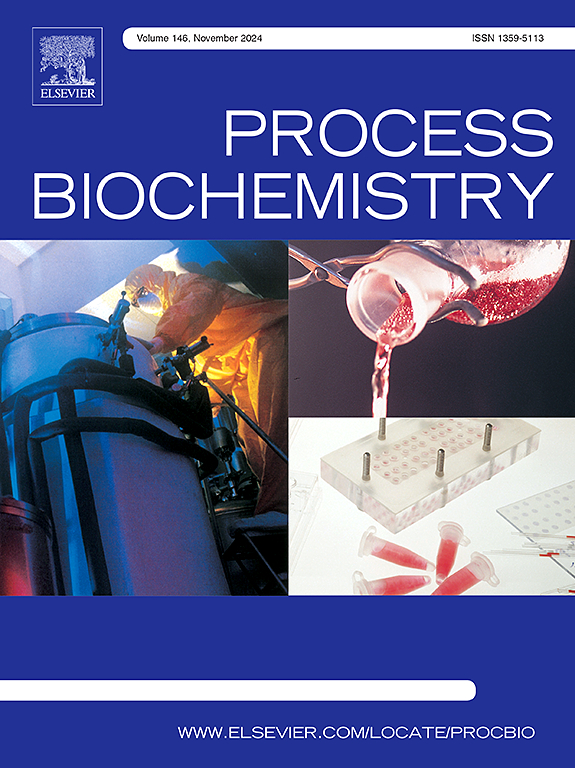Optimization of rice straw pretreatment using microwave-assisted tetrahydrofuran-water systems through response surface methodology for improved sugar recovery
IF 4
3区 生物学
Q2 BIOCHEMISTRY & MOLECULAR BIOLOGY
引用次数: 0
Abstract
A pretreatment process is indispensable for the reduction of biomass recalcitrance to enhance its hydrolytic bioconversion efficiency. A combination of Microwave heating and Tetrahydrofuran-water co-solvent systems was applied to Rice Straw (RS) to improve its sugar conversions. The current study employed a Central Composite Design-based Response Surface Methodology (CCD-RSM) to statistically optimize and study the interaction of different independent variables, like temperature, time, substrate ratio, and enzyme loading, on the total reducing sugar (TRS) yields on the RS pretreatment. At 100 °C and 40 min with 5.0 % (w/v) substrate concentration, the THF–water pretreatment system enabled the highest sugar recovery (76.60 %) from RS, achieved using an enzyme load of 200 U/g substrate. The significance of the pretreatment model was confirmed by ANOVA, with a p-value < 0.05 and an R2 value of 0.97. The crystallinity indices calculated from FTIR and XRD were incorporated into a CCD-RSM model with three factors but were found to be non-significant. However, the reduction observed in the crystallinity indices of pretreated samples, concomitant with their higher sugar yields, indicates effective amorphization of cellulose. Furthermore, the detection of 12 distinct platform chemicals in the pretreatment hydrolysates also highlights the potential sustainability of this method for downstream bioconversions.
利用响应面法优化微波辅助四氢呋喃-水体系预处理水稻秸秆,以提高糖的回收率
预处理工艺是降低生物质抗性,提高其水解转化效率的必要条件。采用微波加热与四氢呋喃-水共溶剂体系相结合的方法,提高了稻秆的糖转化率。本研究采用基于中心复合设计的响应面法(CCD-RSM)统计优化并研究了温度、时间、底物比和酶载量等不同自变量对RS预处理总还原糖(TRS)产率的相互作用。在100°C、40 min、5.0 % (w/v)底物浓度条件下,thf -水预处理系统在酶负荷为200 U/g底物的情况下,从RS中获得最高的糖回收率(76.60 %)。经方差分析证实预处理模型的显著性,p值<; 0.05,R2值为0.97。通过FTIR和XRD计算得出的结晶度指数与三个因素的CCD-RSM模型相结合,但发现不显著。然而,在预处理样品的结晶度指数中观察到的降低,伴随着更高的糖产量,表明纤维素有效的非晶化。此外,在预处理水解物中检测到12种不同的平台化学物质也强调了该方法在下游生物转化中的潜在可持续性。
本文章由计算机程序翻译,如有差异,请以英文原文为准。
求助全文
约1分钟内获得全文
求助全文
来源期刊

Process Biochemistry
生物-工程:化工
CiteScore
8.30
自引率
4.50%
发文量
374
审稿时长
53 days
期刊介绍:
Process Biochemistry is an application-orientated research journal devoted to reporting advances with originality and novelty, in the science and technology of the processes involving bioactive molecules and living organisms. These processes concern the production of useful metabolites or materials, or the removal of toxic compounds using tools and methods of current biology and engineering. Its main areas of interest include novel bioprocesses and enabling technologies (such as nanobiotechnology, tissue engineering, directed evolution, metabolic engineering, systems biology, and synthetic biology) applicable in food (nutraceutical), healthcare (medical, pharmaceutical, cosmetic), energy (biofuels), environmental, and biorefinery industries and their underlying biological and engineering principles.
 求助内容:
求助内容: 应助结果提醒方式:
应助结果提醒方式:


